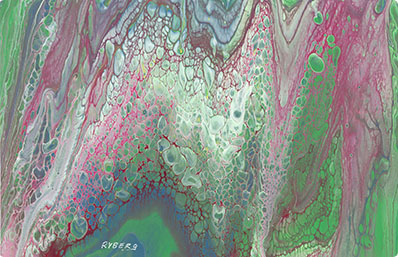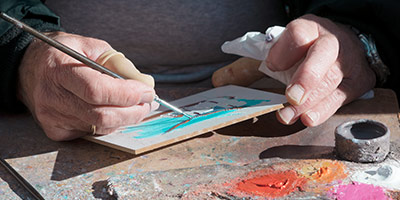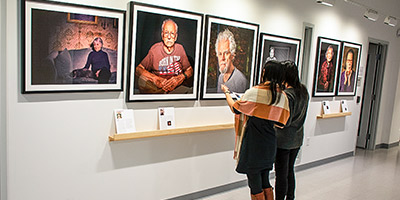
Be a Part of the Fight to End Alzheimer's
Be a Part of the Fight to End Alzheimer's
The millions of people impacted by Alzheimer's disease need your help. Your generosity can help us provide care and support to those facing the challenges of Alzheimer's and advance global research. Please make a gift today.
Donate NowArtist finds escape from dementia, donates proceeds to the cause
When Jim Ryberg creates art, any object can stand in for a paintbrush. Chains, balloons and even flowing water are used to craft Jim's stunning abstract paintings in his assisted living apartment.
Creating art is more than just a hobby for Jim — it helps him manage symptoms of dementia. Jim, 83, also uses painting to fight the disease by donating the proceeds from his art sales to Alzheimer's care, support and research efforts.
Jim started painting 15 years ago when he was living on a hobby farm in central Minnesota. Initially he painted detailed watercolor landscapes of his farm and other nature scenes.
But by 2015, Jim found he was having trouble deciding what to paint — to the point that it became hard to even start. The process made him increasingly anxious, and he eventually found it difficult to compose recognizable images.
Art and music offer many benefits
Art and music can enrich the lives of people living with Alzheimer's. They allow for opportunities for engagement even after dementia has progressed.
A few months later, he started getting lost in familiar places, and struggled to make basic farmhouse repairs even though he worked as a professional homebuilder. Jim visited a doctor and was diagnosed with dementia at age 76.
His doctor said a symptom of dementia can be extreme anxiety — which explained Jim's issues with painting. Jim eventually made the painful decision to stop painting and leave the farm to move into assisted living.
A couple years after moving, Jim was walking through a store when he noticed a display for a special type of art paper that mimics painting on glass. The paper doesn't absorb paint and takes four days to dry, meaning Jim could start a painting, and if he didn't like it or changed his mind, he could wipe away the paint and start over.
 Jim started painting again — trading landscapes for abstract art — and found the experience extremely calming. Whenever he would paint, his anxiety would melt away.
Jim started painting again — trading landscapes for abstract art — and found the experience extremely calming. Whenever he would paint, his anxiety would melt away.
"Now I could put some acrylic paint down and just move it around, and if I liked it, voilà, that is what I was going for," Jim says. "Four days of drying and I had a painting. And if I did not like it, I just started over with something else."
Art projects can have multiple benefits for people living with dementia. Creating art can provide a sense of accomplishment and an opportunity for self-expression.
 "Art-making in general and accessing creative activities can be helpful to all of us — it's another way of expressing, it calms us down and helps us de-stress," says Margaret Carlock-Russo, Ed.D., ATR-BC, ATCS, past president of the American Art Therapy Association and an expressive arts therapy educator at Prescott College. "When you access your creative expression [through art], it is nonverbal, so it alleviates the stress of having to find words for feelings that may be so intense you can't put them into words. For those with a memory or cognition issue, it can be especially challenging to express how they are feeling — yet, they can create imagery because our brains process making imagery differently than verbal communication."
"Art-making in general and accessing creative activities can be helpful to all of us — it's another way of expressing, it calms us down and helps us de-stress," says Margaret Carlock-Russo, Ed.D., ATR-BC, ATCS, past president of the American Art Therapy Association and an expressive arts therapy educator at Prescott College. "When you access your creative expression [through art], it is nonverbal, so it alleviates the stress of having to find words for feelings that may be so intense you can't put them into words. For those with a memory or cognition issue, it can be especially challenging to express how they are feeling — yet, they can create imagery because our brains process making imagery differently than verbal communication."
Jim says rediscovering painting also gave him a renewed sense of purpose.
"I was just so excited; it was a new thing to learn," he says. "And I just couldn't wait to see what I would pick up through trial and error. It became so relaxing."
It's possible to live well with Alzheimer's
You have a choice in how you live your life with Alzheimer's or another dementia. Take control of your health and wellness, and focus your energy on the aspects of your life you find most meaningful.
Jim started to experiment with painting methods and techniques — like replacing brushes with household objects. He'd press paintings together to merge colors, run them under water to create otherworldly patterns and pour glue in the paint to create rippling bubbles.
Jim names each of his finished paintings with a formula: Dementia Delight #1, Dementia Delight #2 and so on. This eliminates the anxiety of deciding on a name while allowing the viewer to interpret each painting's meaning.
Although Jim has painted over 3,000 pieces, only 800 have been finalized with an assigned number. Of those, 352 paintings were selected by Jim to publicly display and sell on his website — where people can order prints or have the artwork placed on everything from greeting cards to coffee mugs to T-shirts.
 Since creating the website in 2021, Jim has donated 90% of sales to the Alzheimer's Association Minnesota-North Dakota Chapter. He has also donated several original paintings to the chapter for event auctions, with the artwork drawing the highest bid of any item.
Since creating the website in 2021, Jim has donated 90% of sales to the Alzheimer's Association Minnesota-North Dakota Chapter. He has also donated several original paintings to the chapter for event auctions, with the artwork drawing the highest bid of any item.
Jim says he's proud that his passion for art can help make a difference for everyone facing the disease.
"With dementia it is really easy to get down on yourself. You get disappointed with yourself, you can't do things you used to do, you don't remember things. If you are just sitting, that is when depression can set in," he says. "Painting, it involves me totally, and that is a huge help — I don't know I have anxiety when I'm painting."
To view or purchase Jim's art, visit jim-ryberg.pixels.com.
Read More ALZ Magazine Articles

Blog posts
No Time Like the Present

Blog posts
Creating and Connecting Through Art

Blog posts
Dementia Through a Different Lens

The first survivor of Alzheimer's is out there, but we won't get there without you.
Donate Now
Learn how Alzheimer’s disease affects the brain.
Take the Brain Tour
